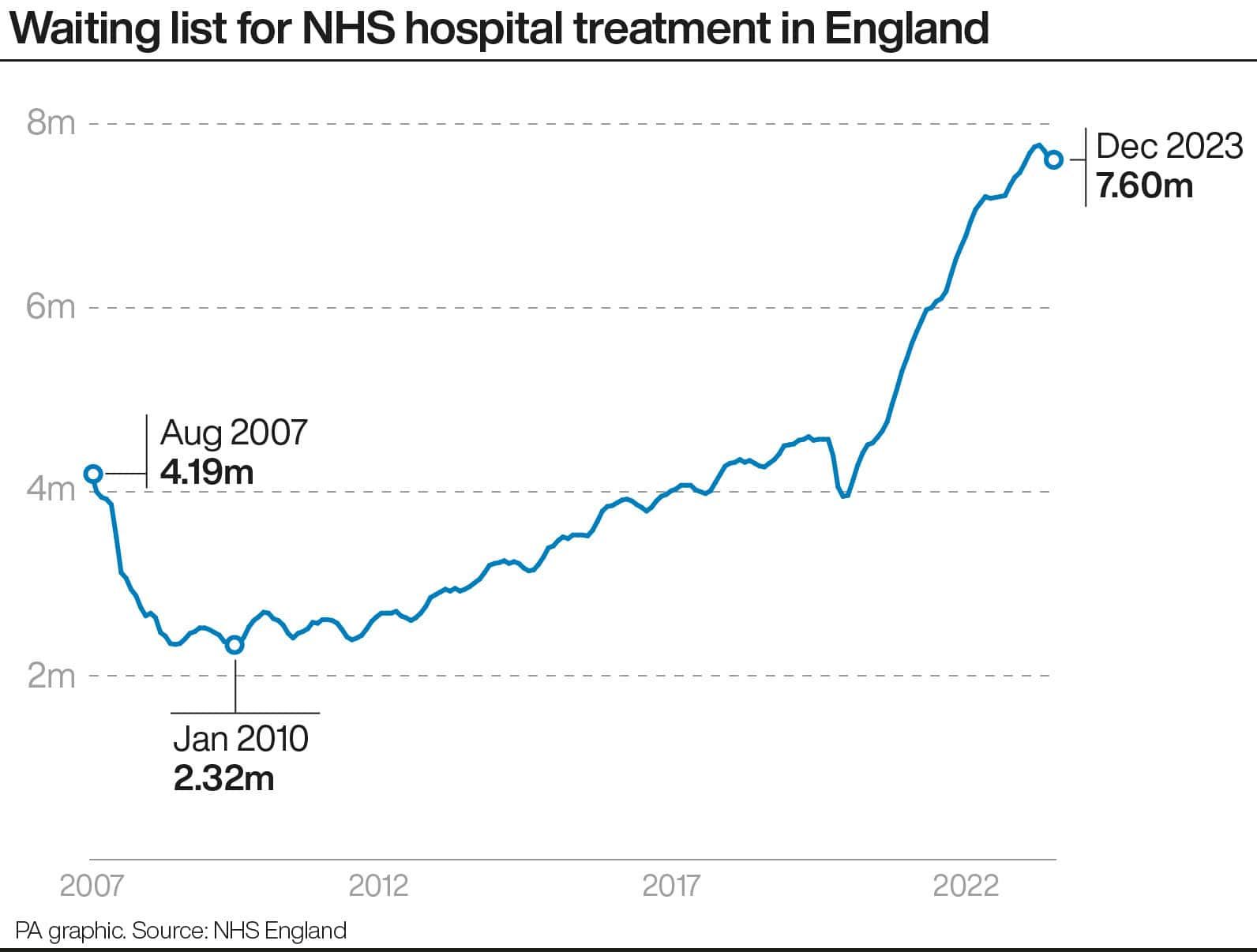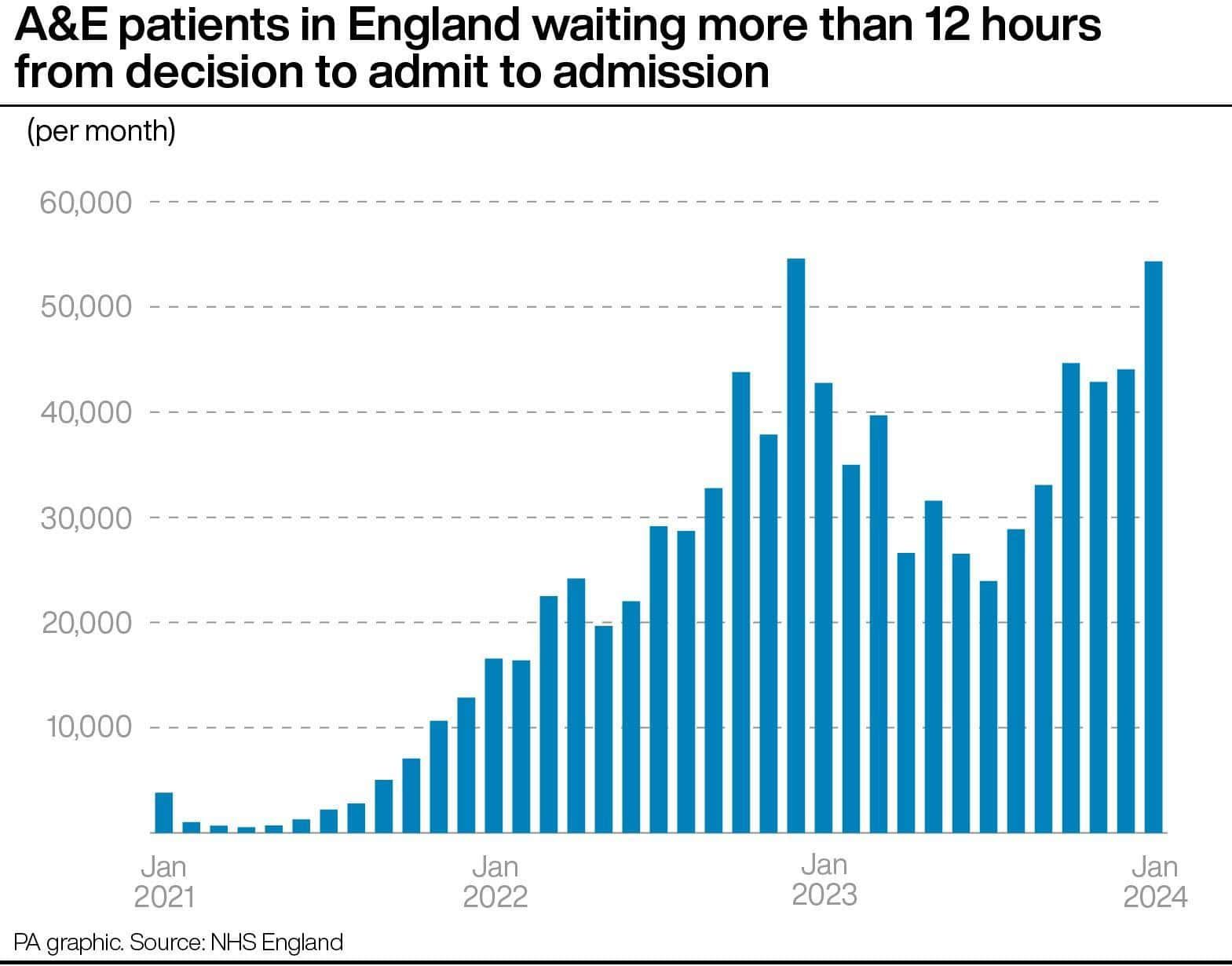The overall waiting list for treatment has fallen slightly and cancer referrals have improved, but more people are waiting longer in A&E departments.
Here are the key figures from the latest NHS performance data for England:
Overall waiting list
The waiting list for routine hospital treatment has fallen for the third month in a row.
An estimated 7.60 million treatments were waiting to be carried out at the end of December, relating to 6.37 million patients, down slightly from 7.61 million treatments and 6.39 million patients at the end of November.

The waiting list for treatments has been growing for much of the last 10 years, passing three million in 2014, four million in 2017, five million in 2021 and seven million in 2022.
In February 2020, the last full month before the start of the Covid-19 pandemic, it stood at 4.57 million.
Long waits for treatment
There were 13,164 people waiting more than 18 months to start routine hospital treatment at the end of December 2023, up from 11,168 at the end of November.
The Government and NHS England set the ambition of eliminating all waits of more than 18 months by April 2023, excluding exceptionally complex cases or patients who choose to wait longer.
The number of people waiting more than 65 weeks has also risen, from 94,563 in November to 98,374 in December.
Some 337,450 people had been waiting more than 52 weeks to start routine hospital treatment at the end of December, down from 355,412 at the end of November.
The Government and NHS England have set the ambition of eliminating all waits of more than a year by March 2025.
Accident & emergency waits
Some 54,308 people had to wait more than 12 hours in A&E departments in January from a decision to admit to actually being admitted, up sharply from 44,045 in December and the second highest figure on record.
The total is just below the record of 54,573 set in December 2022.
The number waiting at least four hours from the decision to admit to admission has also risen, from 148,282 in December to 158,721 last month – again, the second highest figure on record.

Meanwhile, 70.3 per cent of patients were seen within four hours in A&Es last month, up from 69.4 per cent in December.
The figure hit a record low of 65.2 per cent in December 2022.
The NHS recovery plan sets a target of March 2024 for 76 per cent of patients attending A&E to be admitted, transferred or discharged within four hours.
Cancer referrals
A total of 74.2 per cent of patients urgently referred for suspected cancer in December 2023 were diagnosed or had cancer ruled out within 28 days, up from 71.9 per cent the previous month.
The target is 75 per cent.
The proportion of patients waiting longer than 62 days in December from an urgent suspected cancer referral or consultant upgrade to their first definitive treatment for cancer was 65.9 per cent, up slightly from 65.2 per cent in November.
The target is 85 per cent.
GPs in England made 219,841 urgent cancer referrals in December, down from 269,631 in November but up year-on-year from 213,636 in December 2022.
Cancer diagnostic waiting list
The number of patients in England waiting longer than 62 days since an urgent GP referral for suspected cancer was 23,756 in the week ending December 31 2023, up from 22,869 in the week ending November 26.
The figure was nearly 34,000 at the end of September 2022.
Most of the patients included in this total do not have cancer and are waiting for a diagnostic test, while around one in six do have cancer and are waiting for treatment.
The Government and NHS England set the ambition of returning this figure to pre-pandemic levels by March 2023.
The average weekly figure for the pre-pandemic month of February 2020 (covering the four weeks to March 1) was 13,463.
Ambulance response times
The average response time in January for ambulances in England dealing with the most urgent incidents, defined as calls from people with life-threatening illnesses or injuries, was eight minutes and 26 seconds.
This is down from eight minutes and 44 seconds in December but is above the target standard response time of seven minutes.
Ambulances took an average of 40 minutes and six seconds last month to respond to emergency calls such as heart attacks, strokes and sepsis.
This is down from 45 minutes and 57 seconds in December while the target is 18 minutes.
Response times for urgent calls, such as late stages of labour, non-severe burns and diabetes, averaged two hours, 12 minutes and 48 seconds in January, down from two hours, 37 minutes and five seconds in December.
Delayed discharges
An average of 13,709 hospital beds per day last month were occupied by people ready to be discharged.
This is up sharply from 12,610 in December and is the third highest figure since comparable records began in April 2021.
The equivalent number for January 2023 was 13,965 – the highest on record.
On average, 43 per cent of patients ready to leave hospital last month were actually discharged each day, down from 45 per cent in December.
Diagnostic tests
More than 415,000 people had been waiting longer than six weeks for a key diagnostic test in December.
Some 416,889 patients, 26.8 per cent of the total, were waiting longer than six weeks for one of 15 standard tests, including an MRI scan, non-obstetric ultrasound or gastroscopy.
The figure is up from 375,151 (23.3 per cent of the total) in November, but lower than the equivalent figure for December 2022, which was 481,924 (31.3 per cent).
The NHS elective recovery plan sets the ambition that 95 per cent of patients needing a diagnostic test receive it within six weeks by March 2025.

